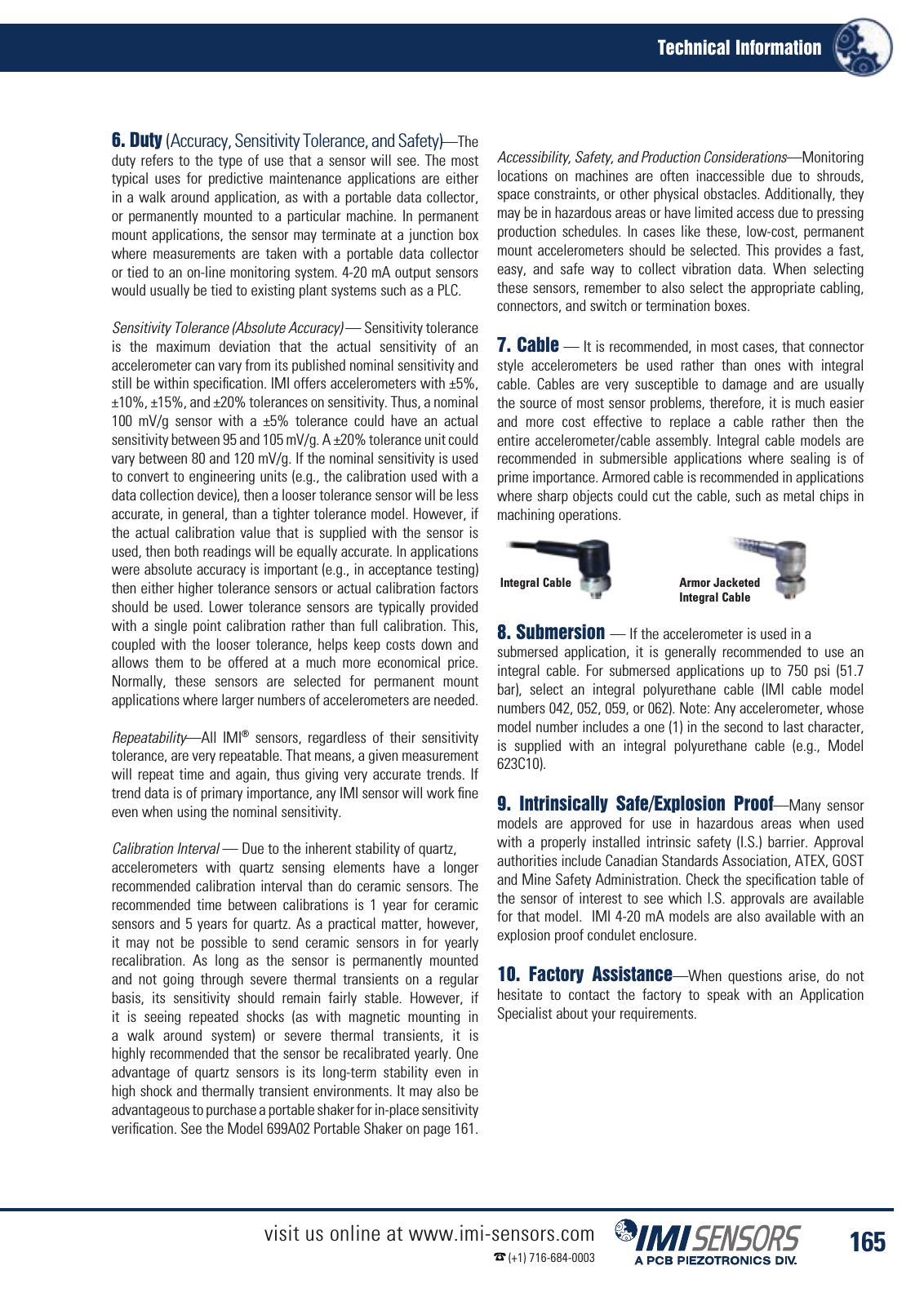IMI Industrial Vibration Sensors Katalog Seite 168
Hinweis: Dies ist eine maschinenlesbare No-Flash Ansicht.Klicken Sie hier um zur Online-Version zu gelangen.
Inhalt
6 Duty Accuracy Sensitivity Tolerance and Safety The duty refers to the type of use that a sensor will see The most typical uses for predictive maintenance applications are either in a walk around application as with a portable data collector or permanently mounted to a particular machine In permanent mount applications the sensor may terminate at a junction box where measurements are taken with a portable data collector or tied to an on line monitoring system 4 20 mA output sensors would usually be tied to existing plant systems such as a PLC Sensitivity Tolerance Absolute Accuracy Sensitivity tolerance is the maximum deviation that the actual sensitivity of an accelerometer can vary from its published nominal sensitivity and still be within specification IMI offers accelerometers with 5 10 15 and 20 tolerances on sensitivity Thus a nominal 100 mV g sensor with a 5 tolerance could have an actual sensitivity between 95 and 105 mV g A 20 tolerance unit could vary between 80 and 120 mV g If the nominal sensitivity is used to convert to engineering units e g the calibration used with a data collection device then a looser tolerance sensor will be less accurate in general than a tighter tolerance model However if the actual calibration value that is supplied with the sensor is used then both readings will be equally accurate In applications were absolute accuracy is important e g in acceptance testing then either higher tolerance sensors or actual calibration factors should be used Lower tolerance sensors are typically provided with a single point calibration rather than full calibration This coupled with the looser tolerance helps keep costs down and allows them to be offered at a much more economical price Normally these sensors are selected for permanent mount applications where larger numbers of accelerometers are needed Repeatability All IMI sensors regardless of their sensitivity tolerance are very repeatable That means a given measurement will repeat time and again thus giving very accurate trends If trend data is of primary importance any IMI sensor will work fine even when using the nominal sensitivity Calibration Interval Due to the inherent stability of quartz accelerometers with quartz sensing elements have a longer recommended calibration interval than do ceramic sensors The recommended time between calibrations is 1 year for ceramic sensors and 5 years for quartz As a practical matter however it may not be possible to send ceramic sensors in for yearly recalibration As long as the sensor is permanently mounted and not going through severe thermal transients on a regular basis its sensitivity should remain fairly stable However if it is seeing repeated shocks as with magnetic mounting in a walk around system or severe thermal transients it is highly recommended that the sensor be recalibrated yearly One advantage of quartz sensors is its long term stability even in high shock and thermally transient environments It may also be advantageous to purchase a portable shaker for in place sensitivity verification See the Model 699A02 Portable Shaker on page 161 Accessibility Safety and Production Considerations Monitoring locations on machines are often inaccessible due to shrouds space constraints or other physical obstacles Additionally they may be in hazardous areas or have limited access due to pressing production schedules In cases like these low cost permanent mount accelerometers should be selected This provides a fast easy and safe way to collect vibration data When selecting these sensors remember to also select the appropriate cabling connectors and switch or termination boxes 7 Cable It is recommended in most cases that connector style accelerometers be used rather than ones with integral cable Cables are very susceptible to damage and are usually the source of most sensor problems therefore it is much easier and more cost effective to replace a cable rather then the entire accelerometer cable assembly Integral cable models are recommended in submersible applications where sealing is of prime importance Armored cable is recommended in applications where sharp objects could cut the cable such as metal chips in machining operations 8 Submersion If the accelerometer is used in a submersed application it is generally recommended to use an integral cable For submersed applications up to 750 psi 51 7 bar select an integral polyurethane cable IMI cable model numbers 042 052 059 or 062 Note Any accelerometer whose model number includes a one 1 in the second to last character is supplied with an integral polyurethane cable e g Model 623C10 9 Intrinsically Safe Explosion Proof Many sensor models are approved for use in hazardous areas when used with a properly installed intrinsic safety I S barrier Approval authorities include Canadian Standards Association ATEX GOST and Mine Safety Administration Check the specification table of the sensor of interest to see which I S approvals are available for that model IMI 4 20 mA models are also available with an explosion proof condulet enclosure 10 Factory Assistance When questions arise do not hesitate to contact the factory to speak with an Application Specialist about your requirements Integral Cable Armor Jacketed Integral Cable Technical Information visit us online at www imi sensors com 1 716 684 0003 165
